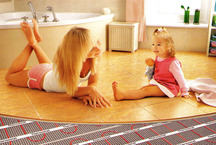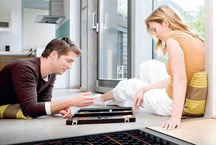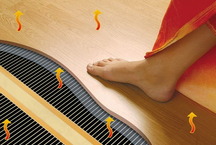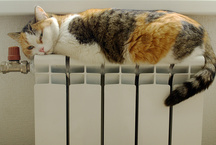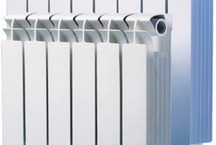Everybody knows about this modern heating system. But few are ready to understand that the “Warm Floor” system itself cannot provide high quality heating for the whole house or apartment by itself. It should work in conjunction with traditional, conventional radiators - and only then underfloor heating can fully show its potential to the homeowner. Including economic. What type of complexes to prefer? Let's talk about this in this article.
Without water - not much ...
The first thing to talk about is the diversity of underfloor heating systems. How many are there now? Lot. But the main - three types. It is water, it is electrocable and it is infrared. In general, you can draw an approximate list as follows - a heated floor is:
- Water;
- Cable;
- Contour;
- Film;
- Thermomats;
- Infrared film.
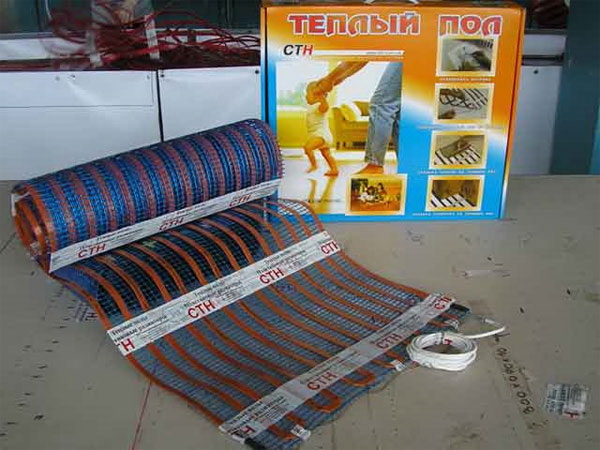
And even in these subtypes have their own varieties, so do not get into the wilds. The main thing is to determine which of them suits us best. And again we will not walk on the details of the technical characteristics, let's say at once: the most convenient is the water one. Because there is central heating in almost every house or apartment. And it is with a coolant that moves through the pipes - that is, with water heated to a certain temperature. The water system of a heat-insulated floor also is connected to it. It is simple, it is fast, it is available. And we are talking today about the choice of priorities for the water-type floor heating. Therefore, right now and begin!
In houses where there are two floors and more, heating of rooms on the floor is usually arranged in the living room and hall, which are located on the first, lower floor. The upper floors are heated with radiators, as floor heating slightly increases the load on the floors - this is due to the rather large inertia of such a heating system. Inertia does not allow creating an optimal microclimate indoors.
Underfloor heating has more inertia than radiators, as the floor heating is slow, as well as cooling.
This is due to the high heat capacity of the cement screed, in which the floor heating pipes are laid. Hence, a large load on the overlap. Radiators heat the air in the room much faster than any floor system, but the air will cool down faster when the coolant temperature in the radiators drops. That is why the best can be called the use of radiators and underfloor heating combined, together.
.jpg)
Photo: master-ur.ru
The contour of the underfloor heating has a temperature of no more than 55 degrees, it is much lower than in the radiator. At the same time, the floor itself is heated not higher than 35 degrees, but gives the accumulated heat to the room for a very long time.
Conditions for creating a combined heating
The system "warm floor" should be open, and not be located under the furniture or carpeting. Therefore, in some rooms, for example, where there is a lot of furniture, you have to completely abandon such a system, because there is very little space left on the floor. An example of this is a combined bathroom or bathroom with a large jacuzzi.
Another problem that may arise when designing floor heating is the device on the upper floors of an additional screed, in which pipes should be located, this was talked about a little higher. The overlap is not originally designed for such bearing loads, so it may simply not withstand. A water-heated floor requires the device most massive screed! Therefore, before designing a combined heating system - carefully study all the necessary conditions for its proper functioning.
.jpg)
Choice of underfloor heating
With this choice, it is necessary to make a difficult decision with the work of two subsystems powered in parallel. And at the same time they must be equipped with its own separate circulation pump. To regulate the temperature of the water in the pipes, a special three-way valve is installed, controlled, in turn, by the weather regulator. Heating radiators are equipped with thermostatic valves. The valves open automatically, provided that one of the contours of the heated floor alone can not cope with the full heating of the room. When closing automatic valves on radiators, the circulation pump should also stop. It will be very good if the pump is turned on in the system with the possibility of independent electronic adjustment of revolutions. Together with the flow resistance in this case, its performance will also change. When the automatic thermostatic valves close completely, the blades of such a pump will stop due to the increase in pressure in the heating system. The pump when the blades are stopped will simply turn off.
The choice of radiators for underfloor heating
The temperature of the floor, more precisely, its surface, should not be more than 29 degrees in a residential area; for a bathroom, this figure can reach 33 degrees. But the temperature of the radiators is much higher than the maximum allowable temperature for a warm floor. Therefore, the coolant, then entering the contour of a warm floor, must be cooled. This problem is solved by including thermostatic valves in all circuits of the floor heating system. They constantly limit the temperature of the water that enters the pipes under the floor.
.jpg)
Photo: san-teh-nik.ru
The head of such a thermostatic valve is capable of reacting to the coolant temperature in the circuit, but does not react to the air temperature in the rooms, as thermostatic valves do. For any increase in the temperature of the water that enters the coil, this valve blocks access until the coolant cools to the temperature that it is supposed to under conditions, that is, to the control value. Thermostatic valves are located in a specially arranged distribution housing in order to preserve the aesthetic appearance of the interior. However, special gates are available today, which can be placed in a wall box.
If you use radiators and floor heating combined, you will need to take into account the flow of coolant and the resistance of this flow. Both at a radiator, and at a coil such resistance should be approximately identical. And the contours need to be connected to the general system in parallel. The area occupied by the coil should not be more than 15 square meters, as otherwise the resistance to the flow of the coolant will be too large. But an obvious plus: the installation of such a system is quite simple, and will cost you quite inexpensively.
Contour separation
If you have a big house, it means that a large area will be heated. Then it will be more profitable and more convenient to make the contours of the floor heating and radiators independent of each other. The science of hydraulics teaches us about this and recalls the convenience of handling and control. Such a solution will not be so cheap, but in return you will receive a high reliability of the system during its operation.
Independent heating circuits are much easier to regulate. Headers are used to connect them - these are pipe sections in the system that have a larger diameter than the main ones. This solution will help to somewhat reduce the flow rate of water, which will facilitate the adjustment of each individual circuit. You can adjust the speed with three-way valves, which will be controlled by a weather regulator. The valves can be inserted at each inlet of the circuit directly in front of the circulation pump.
.jpg)
Photo: ideas.vdolevke.ru
More than convenient separate contours? With this system, you can separately set different temperatures in different rooms and rooms. And even if there is a different type of heating in these rooms. Separate systems, in turn, are also divided into subsystems, this makes it possible to maintain different temperatures. Which, of course, increases the level of comfort in the house. And yet - allows you to save money that is spent on heating in general. For example, there are such types of premises that are not regularly used - it can be a guest room or a pantry - there you can lower the temperature to a minimum. Very often, such heating systems are included in the overall “Smart Home” system, where, using such separate circuits, the software controls the temperature throughout the house.
Heating systems with multiple circuits can also be used in cases where the heating boiler has limited control capabilities. Then, with the help of three-way valves, the problem of the “extra” temperature in a separate heating circuit is simply solved. And while the boiler itself is not regulated, and continues to work with the highest efficiency.
